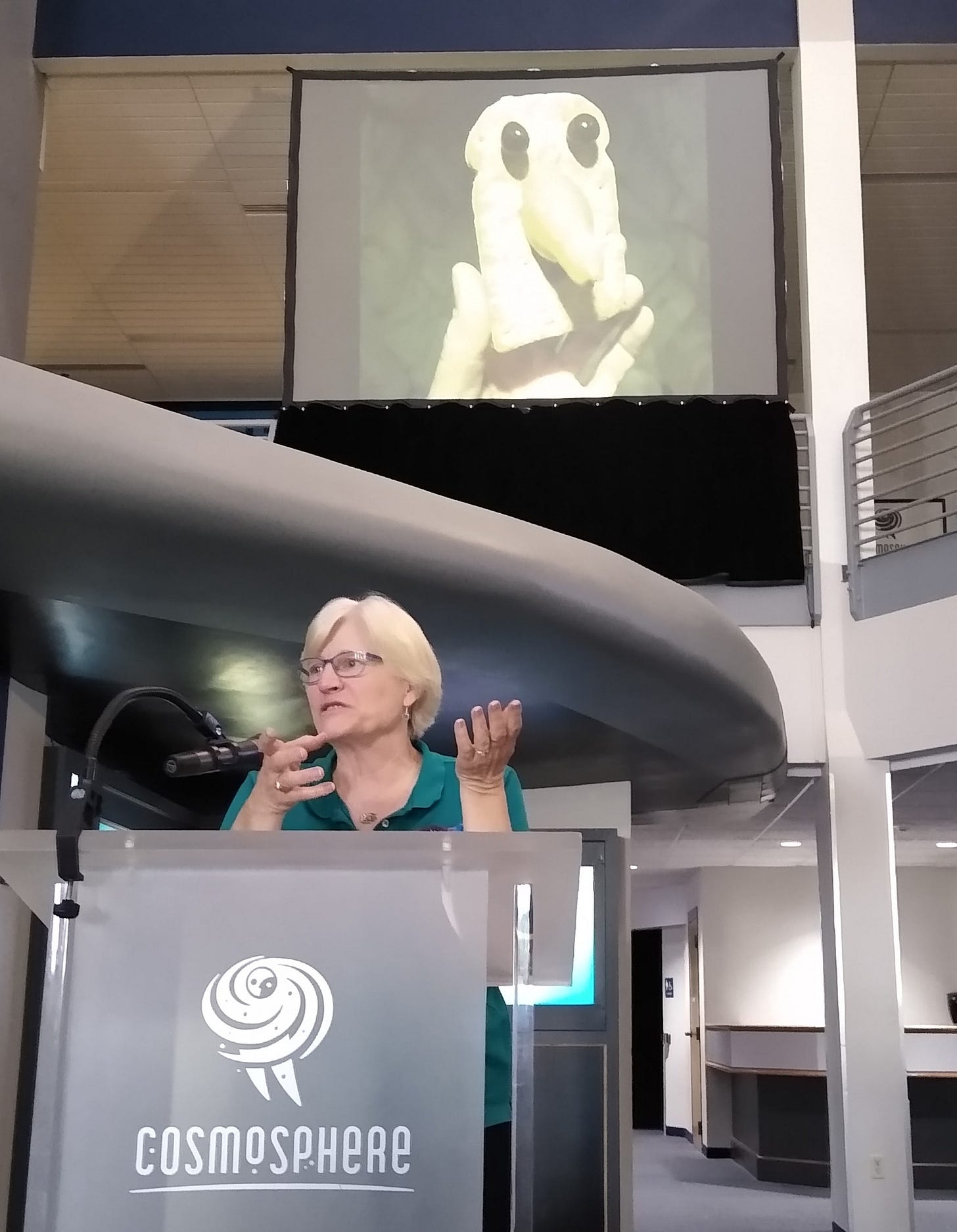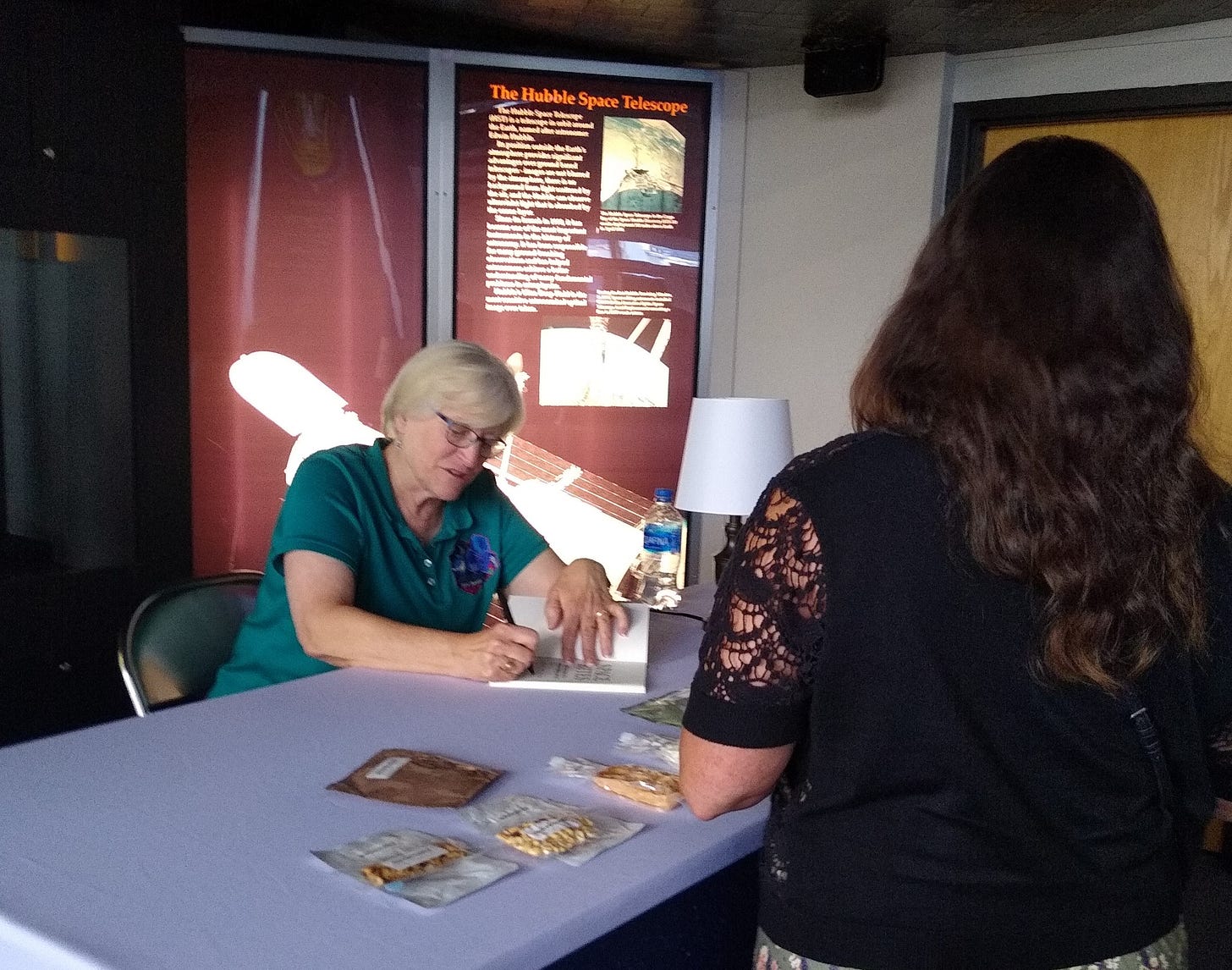According to NASA food scientist, space ice cream not popular in space but shrimp cocktail is

Vickie Kloeris, retired NASA food scientist and author of “Space Bites: Reflections of a NASA Food Scientist,” told stories at the Cosmosphere on July 10 of her experiences with developing space food. She said, “Space ice cream is not a favorite of astronauts, because it is not really like ice cream and it’s kinda crumbly. It’s more of a kid’s treat. And food particles in space are not just inconvenient but can be dangerous in limited gravity if they get in someone’s eye or are inhaled.”
At the beginning of her presentation, Kloeris complimented the Cosmoshpere. She said, “You’ve got some really cool stuff here that the Air and Space Museum doesn’t even have. The Apollo and early space artifacts are amazing!”
Kloeris has worked in space food systems for 34 years, primarily for the Space Shuttle and the International Space Station at the Johnson Space Center in Houston, Texas. She wanted to write a book about her supervisor and mentor and some others in the NASA food system who had recently passed. And then the COVID-19 pandemic happened. She thought, “If I'm ever going to do this, now is the time.”
She wrote 90% of the book in 2020. But when vaccinations became available and restrictions lifted, she got busy again. It took her two years to finish the last 10% of the book.

Kloeris explained that the usable space inside the International Space Station (ISS) is roughly the size of a three-bedroom apartment. And food storage and preparation take up a lot of that space. As the number of people staying at ISS grew and the duration of time they stayed also grew, it became extremely important that the packaging of the food took up as little space as possible.
Some examples she gave were drink pouches and MREs (Meal Ready to Eat). When she started, beverages were in a tray, much like a plastic storage container. These containers took up too much space and made too much trash.
They began looking at other options for beverage packaging. What they came up with was a package much like what one would find with a Capri-Sun drink but with a tube to inject water into it and a clamp to stop the liquid from escaping. They used orange Tang, a powdered, ready-to-drink mix once water is added.
She said that NASA did not invent Tang, but because it was so easy to use in space, NASA just bought it. Tang manufacturers were so excited, they sold NASA their other flavors like mango and pineapple which at the time were sold in other countries.
MREs posed a different problem. The packaging was already sufficient for space because the government had already eliminated the can. But, the food itself was too salty. Kloeris said that the salt and fat in MREs are very important for soldiers on the ground, but bone and muscle mass decrease the longer a person is in space, and salt can exacerbate that bone loss.
“We began to develop these low-salt, thermostabilized products in the mid-1990s,” said Kloeris. About 50% of the food sent into space were these customized food formulas. “The rest were purchased off the shelf and repackaged.”
Food had to be repackaged because different packaging can give off gasses that can become harmful in the enclosed space station. “You can’t open a window to air things out in space,” said Kloeris.
Kloeris and the other food scientists also experimented with many different ways of extending the shelf life of food in space. Intermediate moisture food, like dried beef or fruit, was often used. They used the retort method to apply heat and pressure to packaged and sealed food, “much like grandma would do while canning,” said Kloeris.
They also used an irradiation method to eliminate bacteria, but this method is not available for commercial use. With this method, a piece of meat can stay intact and still be safe to eat.
Condiments are popular and “lots were sent to space,” said Kloeris. When crew members are first in space, the fluids in their bodies accumulate in their heads, making them congested. And much like when one has a cold, they can’t taste as well. Also, aromas are different in space. They can’t always heat meals, packaging inhibits aroma, and heat dissipates differently.
“All of these obstacles to taste make hot sauce extremely popular,” said Kloeris.
And because of that, there is one food many crew members really like, and that is a shrimp cocktail. “The horseradish gives it that extra kick,” said Kloeris. She told a story of American Astronaut, Peggy Whitson, who would ask for an extra shrimp cocktail in her “preference container” to bribe others even though she didn’t like it.
Kloeris said that through experiments and feedback from crew members, they discovered the best system was to have a standard menu for everyone at the ISS, and then the crew was allowed a smaller “preference container.” To try to have an individualized menu for everyone on board took up too much space and was extremely difficult logistically.
They also learned that tortillas in space are very popular. Bread is messy and creates crumbles. In the 1990s, tortillas were not as popular as they are today, and finding a tortilla with a stable shelf life was impossible. So NASA started making their own tortillas with a binder and low-water action. After a few years, Taco Bell started selling a shelf-stable soft tortilla. NASA switched to purchasing the tortillas from the manufacturer and then stopped making their own tortillas.
Kloeris also talked about being from the ‘duck and cover’ generation where they were taught in school to hide under their desks in case of a missile strike from Russia, but all the kids knew that would not help them live. But working in the space food system, she had to work with other countries.
“I never dreamed I would someday travel to Russia,” said Koleris. “But I learned that they were nice people, and scientists can put aside their politics and get the work done. It can be done if people want to do it.”
After the presentation and during the question and answer session, a pre-teen boy asked about her favorite space food. Her reply was, “Cherry blueberry cobbler. Because it can be heated up, and heated desserts [and other varieties of foods] can be psychologically important in space. But it would be better with ice cream.”
“Space Bites” book is available at the Cosmosphere gift store or on her website, www.vickiekloeris.com





